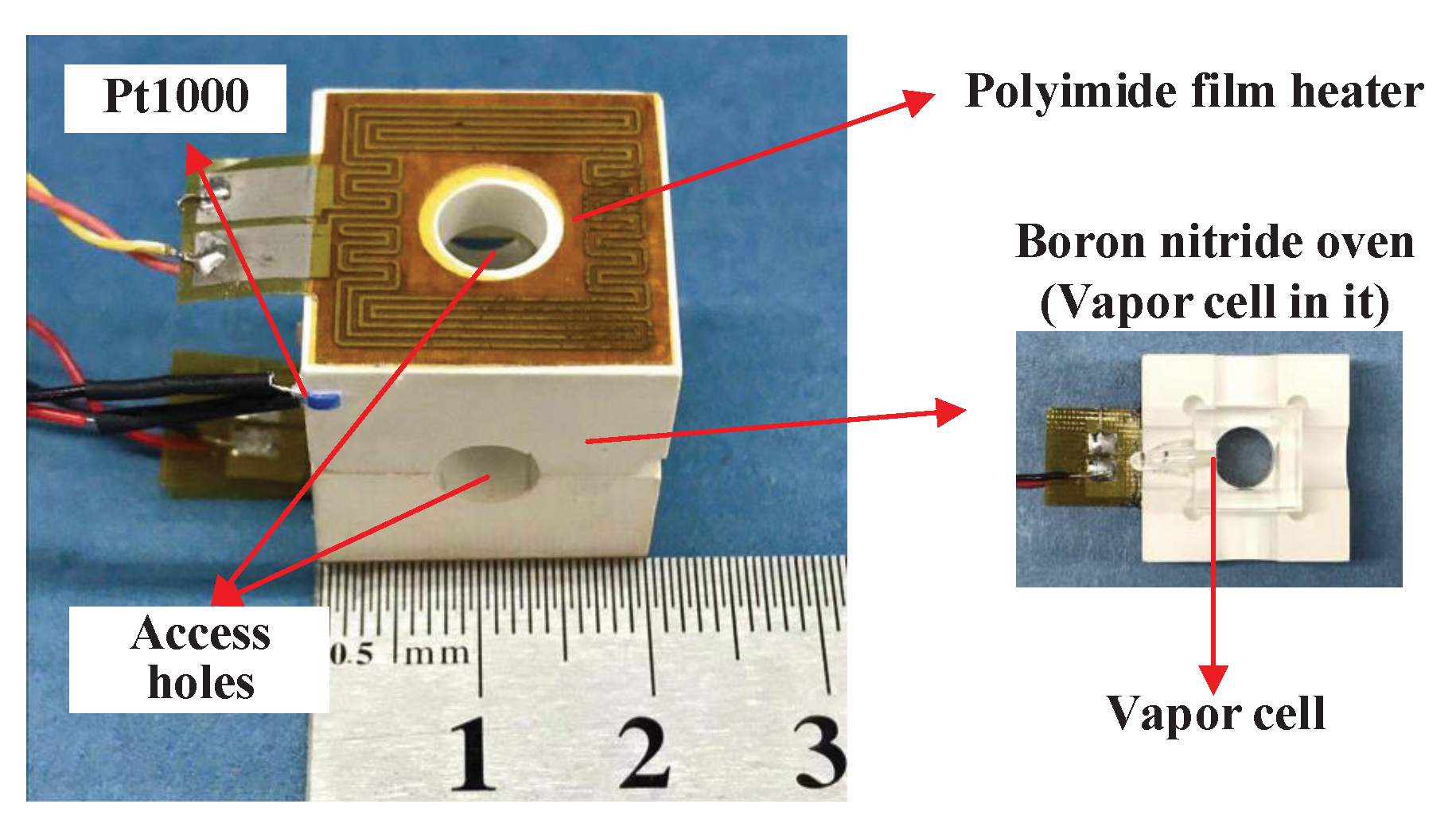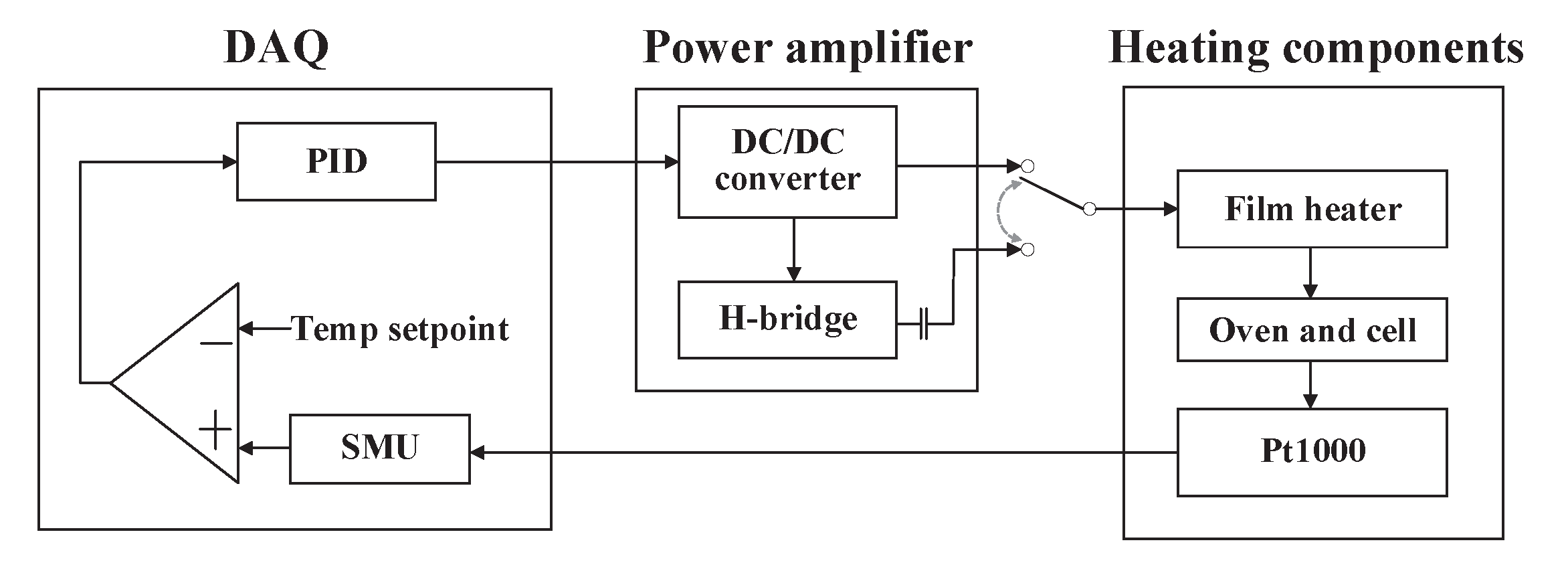In-Situ Measurement of Electrical-Heating-Induced Magnetic Field for an Atomic Magnetometer
Abstract
1. Introduction
2. Method
3. Experimental Setup and Procedure
4. Experimental Results and Discussion
5. Conclusions
Author Contributions
Funding
Conflicts of Interest
References
- Boto, E.; Holmes, N.; Leggett, J.; Roberts, G.; Shah, V.; Meyer, S.S.; Muñoz, L.D.; Mullinger, K.J.; Tierney, T.M.; Bestmann, S.; et al. Moving magnetoencephalography towards real-world applications with a wearable system. Nature 2018, 555, 657–661. [Google Scholar] [CrossRef] [PubMed]
- Kitching, J. Chip-scale atomic devices. Appl. Phys. Rev. 2018, 5, 031302. [Google Scholar] [CrossRef]
- Zhang, G.; Huang, S.; Xu, F.; Hu, Z.; Lin, Q. Multi-channel spin exchange relaxation free magnetometer towards two-dimensional vector magnetoencephalography. Opt. Express 2019, 27, 597–607. [Google Scholar] [CrossRef] [PubMed]
- Alem, O.; Sander, T.H.; Mhaskar, R.; LeBlanc, J.; Eswaran, H.; Steinhoff, U.; Okada, Y.; Kitching, J.; Trahms, L.; Knappe, S. Fetal magnetocardiography measurements with an array of microfabricated optically pumped magnetometers. Phys. Med. Biol. 2015, 60, 4797–4811. [Google Scholar] [CrossRef] [PubMed]
- Lembke, G.; Erné, S.N.; Nowak, H.; Menhorn, B.; Pasquarelli, A. Optical multichannel room temperature magnetic field imaging system for clinical application. Biomed. Opt. Express 2014, 5, 876–881. [Google Scholar] [CrossRef] [PubMed]
- Borna, A.; Carter, T.R.; DeRego, P.; James, C.D.; Schwindt, P.D.D. Magnetic source imaging using a pulsed optically pumped magnetometer Array. IEEE Trans. Instrum. Meas. 2019, 68, 493–501. [Google Scholar] [CrossRef]
- Safronova, M.S.; Budker, D.; DeMille, D.; Kimball, D.F.J.; Derevianko, A.; Clark, C.W. Search for new physics with atoms and molecules. Rev. Mod. Phys. 2018, 90, 025008. [Google Scholar] [CrossRef]
- Wang, T.; Kimball, D.F.J.; Sushkov, A.O.; Aybas, D.; Blanchard, J.W.; Centers, G.; O’Kelley, S.R.; Wickenbrock, A.; Fang, J.; Budker, D. Application of spin-exchange relaxation-free magnetometry to the cosmic axion spin precession experiment. Phys. Dark. Universe 2018, 19, 27–35. [Google Scholar] [CrossRef]
- Dang, H.B.; Maloof, A.C.; Romalis, M.V. Ultrahigh sensitivity magnetic field and magnetization measurements with an atomic magnetometer. Appl. Phys. Lett. 2010, 97, 151110. [Google Scholar] [CrossRef]
- Allred, J.C.; Lyman, R.N.; Kornack, T.W.; Romalis, M.V. High-sensitivity atomic magnetometer unaffected by spin-exchange relaxation. Phys. Rev. Lett. 2002, 89, 130801. [Google Scholar] [CrossRef]
- Fang, J.; Li, R.; Duan, L.; Chen, Y.; Quan, W. Study of the operation temperature in the spin-exchange relaxation free magnetometer. Rev. Sci. Instrum. 2015, 86, 073116. [Google Scholar] [CrossRef] [PubMed]
- Ito, S.; Ito, Y.; Kobayashi, T. Temperature characteristics of K-Rb hybrid optically pumped magnetometers with different density ratios. Opt. Express 2019, 27, 8037–8047. [Google Scholar] [CrossRef] [PubMed]
- Li, Y.; Liu, X.; Cai, H.; Ding, M.; Fang, J. The optimization of alkali-metal density ratio in hybrid optical pumping atomic magnetometer. Meas. Sci. Technol. 2019, 30, 015005. [Google Scholar] [CrossRef]
- Sheng, J.; Wan, S.; Sun, Y.; Dou, R.; Guo, Y.; Wei, K.; He, K.; Qin, J.; Gao, J. Magnetoencephalography with a Cs-based high-sensitivity compact atomic magnetometer. Rev. Sci. Instrum. 2017, 88, 094304. [Google Scholar] [CrossRef] [PubMed]
- Kominis, I.K.; Kornack, T.W.; Allred, J.C.; Romalis, M.V. A subfemtotesla multichannel atomic magnetometer. Nature 2003, 422, 596–599. [Google Scholar] [CrossRef]
- Ledbetter, M.P.; Savukov, I.M.; Acosta, V.M.; Budker, D.; Romalis, M.V. Spin-exchange-relaxation-free magnetometry with Cs vapor. Phys. Rev. A 2008, 77, 033408. [Google Scholar] [CrossRef]
- Li, Z.; Wakai, R.T.; Walker, T.G. Parametric modulation of an atomic magnetometer. Appl. Phys. Lett. 2006, 89, 134105. [Google Scholar] [CrossRef]
- Taue, S.; Sugihara, Y.; Kobayashi, T.; Ichihara, S.; Ishikawa, K.; Mizutani, N. Development of a highly sensitive optically pumped atomic magnetometer for biomagnetic field measurements: A phantom study. IEEE Trans. Magn. 2010, 46, 3635–3638. [Google Scholar] [CrossRef]
- Sheng, D.; Perry, A.R.; Krzyzewski, S.P.; Geller, S.; Kitching, J.; Knappe, S. A microfabricated optically-pumped magnetic gradiometer. Appl. Phys. Lett. 2017, 110, 031106. [Google Scholar] [CrossRef]
- Alem, O.; Mhaskar, R.; Jiménez-Martínez, R.; Sheng, D.; LeBlanc, J.; Trahms, L.; Sander, T.; Kitching, J.; Knappe, S. Magnetic field imaging with microfabricated optically-pumped magnetometers. Opt. Express 2017, 25, 7849–7858. [Google Scholar] [CrossRef]
- Savukov, I.; Boshier, M. A high-sensitivity tunable two-beam fiber-coupled high-density magnetometer with laser heating. Sensors 2016, 16, 1691. [Google Scholar] [CrossRef] [PubMed]
- Budker, D.; Kimball, D.F.J. Optical Magnetometry; Cambridge University Press: Cambridge, MA, USA, 2013; pp. 97–98. [Google Scholar]
- Lu, J.; Quan, W.; Ding, M.; Qi, L.; Fang, J. Suppression of light shift for high-density alkali-metal atomic magnetometer. IEEE Sen. J. 2019, 19, 492–496. [Google Scholar] [CrossRef]
- Zhao, J.; Ding, M.; Lu, J.; Yang, K.; Ma, D.; Yao, H.; Han, B.; Liu, G. Determination of spin polarization in spin-exchange relaxation-free atomic magnetometer using transient response. IEEE Trans. Instrum. Meas. 2020, 69, 845–852. [Google Scholar] [CrossRef]
- Fu, J.; Du, P.; Zhou, Q.; Wang, R. Spin dynamics of the potassium magnetometer in spin-exchange relaxation free regime. Chin. Phys. B 2016, 25, 010302. [Google Scholar] [CrossRef]
- Lu, J.; Qian, Z.; Fang, J.; Quan, W. Effects of AC magnetic field on spin-exchange relaxation of atomic magnetometer. Appl. Phys. BLasersOpt. 2016, 122, 59. [Google Scholar] [CrossRef]
- Wyllie, R.; Kauer, M.; Smetana, G.; Wakai, R.; Walker, T. Magnetocardiography with a modular spin-exchange relaxation-free atomic magnetometer array. Phys. Med. Biol. 2012, 57, 2619–2632. [Google Scholar] [CrossRef]
- Savukov, I.M.; Zotev, V.S.; Volegov, P.L.; Espy, M.A.; Matlashov, A.N.; Gomez, J.J.; Kraus, R.H., Jr. MRI with an atomic magnetometer suitable for practical imaging applications. J. Magn. Reson. 2009, 199, 188–191. [Google Scholar] [CrossRef]
- Karaulanov, T.; Savukov, I.; Kim, Y.J. Spin-exchange relaxation-free magnetometer with nearly parallel pump and probe beams. Meas. Sci. Technol. 2016, 27, 055002. [Google Scholar] [CrossRef]
- Brown, J.M. A New Limit on Lorentz-and CPT-Violating Neutron Spin Interactions Using a K-3He Comagnetometer. Ph.D. Dissertation, Department of Physics, Princeton University, Princeton, NJ, USA, 2011. [Google Scholar]
- Bulatowicz, M. Electrical Resistive Heaters for Magnetically Sensitive Instruments. In Proceedings of the 45th Annual Meeting of the APS Division of Atomic, Molecular and Optical Physics, Madison, WI, USA, 2–6 June 2014. [Google Scholar]
- Yim, S.H.; Kim, Z.; Lee, S.; Kim, T.H.; Shim, K.M. Note: Double-layered polyimide film heater with low magnetic field generation. Rev. Sci. Instrum. 2018, 89, 116102. [Google Scholar] [CrossRef]
- Liang, X.; Liu, Z.; Hu, D.; Wu, W.; Jia, Y.; Fang, J. MEMS non-magnetic electric heating chip for spin-exchange-relaxation-free (SERF) magnetometer. IEEE Access 2019, 7, 88461–88471. [Google Scholar]
- Seltzer, S.J. Developments in Alkali-Metal Atomic Magnetometry. Ph.D. Thesis, Department of Physics, Princeton University, Princeton, NJ, USA, 2008. [Google Scholar]
- Seltzer, S.J.; Romalis, M.V. Unshielded three-axis vector operation of a spin-exchange-relaxation-free atomic magnetometer. Appl. Phys. Lett. 2004, 85, 4804–4806. [Google Scholar] [CrossRef]
- Kirschvink, J. Uniform magnetic fields and double-wrapped coil systems: Improved techniques for the design of bioelectromagnetic experiments. Bioelectromagnetics 1992, 13, 401–411. [Google Scholar] [CrossRef] [PubMed]
- Jeon, S.; Jang, G.; Choi, H.; Park, S. Magnetic navigation system with gradient and uniform saddle coils for the wireless manipulation of micro-robots in human blood vessels. IEEE Trans. Magn. 2010, 46, 1943–1946. [Google Scholar] [CrossRef]





| Temperature (C) | (nT) | (nT) | (nT) | (nT) | (nT) | (nT) |
|---|---|---|---|---|---|---|
| 150 | 1.35 ± 0.01 | −1.18 ± 0.20 | −2.19 ± 0.01 | 18.94 ± 0.15 | 12.4 ± 0.8 | 22.00 ± 0.35 |
| 160 | 1.35 ± 0.01 | −1.12 ± 0.22 | −2.23 ± 0.01 | 20.34 ± 0.17 | 13.2 ± 0.8 | 23.15 ± 0.30 |
| 170 | 1.35 ± 0.01 | −1.16 ± 0.22 | −2.14 ± 0.01 | 21.14 ± 0.16 | 14.0 ± 0.6 | 24.21 ± 0.27 |
| 180 | 1.35 ± 0.01 | −1.12 ± 0.20 | −2.27 ± 0.01 | 21.54 ± 0.18 | 14.8 ± 0.6 | 25.10 ± 0.25 |
| 190 | 1.34 ± 0.01 | −1.12 ± 0.20 | −2.28 ± 0.01 | 22.74 ± 0.19 | 15.1 ± 0.5 | 25.98 ± 0.25 |
| Temperature (C) | Driving Voltage (V) | Driving Current (mA) | (nT) | (nT) | (nT) |
|---|---|---|---|---|---|
| 150 | 26.53 | 232 | 17.59 ± 0.16 | 13.6 ± 1.0 | 24.19 ± 0.36 |
| 160 | 28.12 | 246 | 18.99 ± 0.18 | 14.3 ± 1.0 | 25.38 ± 0.31 |
| 170 | 29.29 | 256 | 19.79 ± 0.17 | 15.2 ± 0.8 | 26.45 ± 0.28 |
| 180 | 20.49 | 267 | 20.19 ± 0.19 | 15.8 ± 0.8 | 27.37 ± 0.26 |
| 190 | 31.84 | 278 | 21.41 ± 0.20 | 16.2 ± 0.7 | 28.26 ± 0.26 |
| Case | a (nT/mA) | b (nT) |
|---|---|---|
| 0.079 | −0.51 | |
| 0.060 | −0.21 | |
| 0.090 | 3.25 |
© 2020 by the authors. Licensee MDPI, Basel, Switzerland. This article is an open access article distributed under the terms and conditions of the Creative Commons Attribution (CC BY) license (http://creativecommons.org/licenses/by/4.0/).
Share and Cite
Lu, J.; Wang, J.; Yang, K.; Zhao, J.; Quan, W.; Han, B.; Ding, M. In-Situ Measurement of Electrical-Heating-Induced Magnetic Field for an Atomic Magnetometer. Sensors 2020, 20, 1826. https://doi.org/10.3390/s20071826
Lu J, Wang J, Yang K, Zhao J, Quan W, Han B, Ding M. In-Situ Measurement of Electrical-Heating-Induced Magnetic Field for an Atomic Magnetometer. Sensors. 2020; 20(7):1826. https://doi.org/10.3390/s20071826
Chicago/Turabian StyleLu, Jixi, Jing Wang, Ke Yang, Junpeng Zhao, Wei Quan, Bangcheng Han, and Ming Ding. 2020. "In-Situ Measurement of Electrical-Heating-Induced Magnetic Field for an Atomic Magnetometer" Sensors 20, no. 7: 1826. https://doi.org/10.3390/s20071826
APA StyleLu, J., Wang, J., Yang, K., Zhao, J., Quan, W., Han, B., & Ding, M. (2020). In-Situ Measurement of Electrical-Heating-Induced Magnetic Field for an Atomic Magnetometer. Sensors, 20(7), 1826. https://doi.org/10.3390/s20071826






